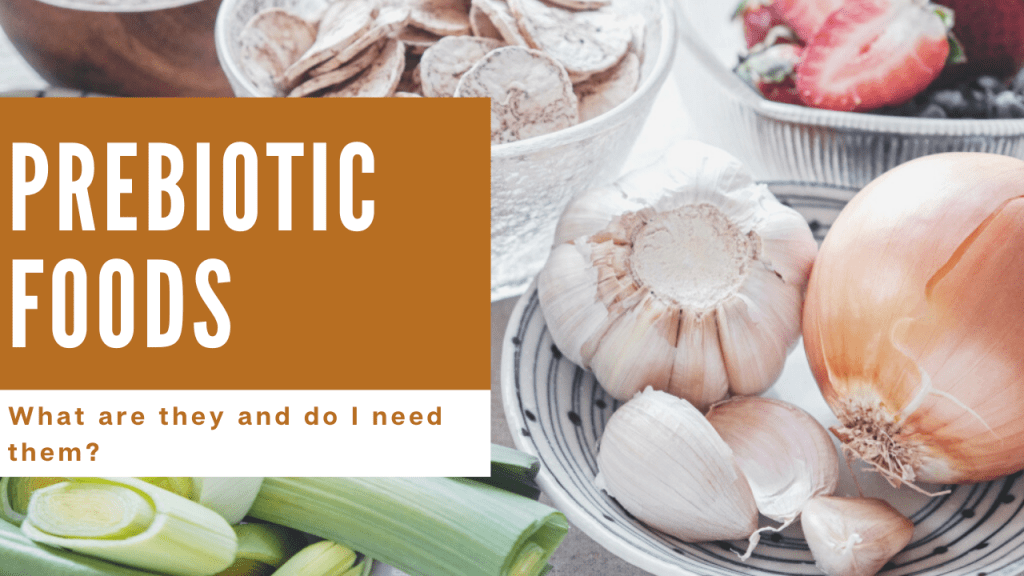 While many people have heard of probiotics, not a lot of people have heard of prebiotics. Prebiotics and probiotics sound similar but have different roles in the digestive system (also known as your gut). Stick around and I’ll tell you why you want to eat more prebiotic foods. Plus, check out the list of prebiotic foods below.
While many people have heard of probiotics, not a lot of people have heard of prebiotics. Prebiotics and probiotics sound similar but have different roles in the digestive system (also known as your gut). Stick around and I’ll tell you why you want to eat more prebiotic foods. Plus, check out the list of prebiotic foods below.
We can get probiotics from yogurt, kombucha, kefir, and supplements. And, we mostly get prebiotics through food. If we are eating with intention, we may not even need supplements.
Probiotics Work Best With Prebiotic Foods
Probiotics are bacteria you are adding back into your body with intention. You have billions of bacteria in your body whether you like it or not. Some people are overrun with bad bacteria, but if you take care of your good bacteria, it can push out the bad bacteria. And you want to have a very healthy gut biome! New studies are now showing how incredibly important having a plethora of good bacteria in your gut is for your long-term health.
The type of bacteria you have in your gut can actually change your personality, it can cause weight gain, and cause brain fog. If you have the more of the good bacteria in your digestive tract then it can help you absorb up to 30-40% more vitamins from food and can provide long-term health benefits. It’s amazing how much we are just learning about the importance of having a healthy gut. You need to make sure you have a healthy biome and you probably can’t do that by just eating the Standard American Diet. You’ll learn more about the Standard American Diet in future posts.

Can I Just Take More Probiotics?
It’s not that easy. You can spend $100 a month on probiotics, but if you’re not doing enough to feed your good bacteria, the bacteria probably won’t stay in your gut long. Your expensive probiotic will probably get flushed down the toilet without much benefit to you. Your bacteria needs you to feed it the foods that your bacteria likes, which might not be the foods that you like to eat.
Plus, many store-bought probiotics are dead by the time you are eating them. It’s better to eat more probiotic foods and get your probiotics from living cultures in food versus from bottles.
Prebiotic foods are some of the best types of foods you can eat to better feed your probiotics and help them stay in your gut longer so you can get all the health benefits mentioned. It’s a symbiotic relationship! You need a good healthy gut flora to be healthy long-term.
What Are Prebiotics?
Prebiotics can come from the foods that you eat, but you need to eat the right kind of foods. Certain foods are harder to digest and that’s when the magic happens. We have more bacteria in our gut than we have cells in our body, and by a lot! And, most of us aren’t doing enough to feed our gut bacteria. We need to be more mindful to what we are eating and why we are eating it.
The more prebiotic food you eat, the better you can feed your bacteria in your gut and keep them in your gut. Plus, you’ll feel a lot better by eating more of these foods!!
Prebiotic fiber is the non-digestible fiber from foods- making it hard for your gut to digest it, so it ferments in your large colon. While that sounds bad, it’s actually a great thing for you! This slows down the digestive process and allows your gut bacteria a chance to eat. And, it gives you a chance to absorb more vitamins from the food you are eating.

Good Gut Bacteria vs Bad Gut Bacteria
So many of our foods are so highly refined that they pass right through us- think of pasta, crackers, cereals, sugar-laden foods, etc. This doesn’t give our good bacteria a chance to eat and prosper in your digestive tract.
Sadly, the Standard American Diet ends up feeding your bad bacteria.
There are really only two kinds of bacteria in your gut the good kind and the bad kind.
There are a lot of strands out there, but let’s just categorize them in good and bad for now. All of the ones you are buying at the store in supplements are the good kind and you also get the good kind from probiotic foods mentioned below.
You get the bad kind from eating simple carbs like pasta, which turns to sugar in your body and from foods loaded in sugar. Bad bacteria loves sugar! Your bad bacteria also loves sports drinks like Gatorade, sodas, juices, sweets of all kinds, Goldfish crackers, pretzels, and the list goes on and on. If you look around that is most of the foods we all eat.
97% of people are not getting enough fiber! There is a good chance you are one of them, but you don’t need to be if you eat with more intention. And, they are really good at thriving. Of course, the good bacteria is a lot more fickle and you have to work way harder to make them happy.
Studies have shown that taking birth control, drinking sodas with artificial sweeteners and of course taking antibiotics can all mess with our gut biome. This just means we have to work harder to make it happy.

We Need Fermentation
Good Bacteria Helps Your Body Absorb More Vitamins
 Did you know that your having more good gut bacteria can help you synthesized additional vitamins from other foods that you eat? Having a healthy gut biome helps you absorb more vitamins from food! The healthier your gut is the healthier you are! If your gut bacteria is off, you may not be absorbing as much vitamins from your food and that can be causing issues in other aspects of your health. Studies now show more than 70% of our immune system comes from our gut.
Did you know that your having more good gut bacteria can help you synthesized additional vitamins from other foods that you eat? Having a healthy gut biome helps you absorb more vitamins from food! The healthier your gut is the healthier you are! If your gut bacteria is off, you may not be absorbing as much vitamins from your food and that can be causing issues in other aspects of your health. Studies now show more than 70% of our immune system comes from our gut.
Plus, they have shown that the healthier your gut biome is the more you can manage your weight, emotions, long-term health, and the list goes on. If you want to read more about the importance of gut health, check out this book called The Good Gut. It’s a wonderful book about how your gut biome impacts your weight, mood and long-term health.
Prebiotic Foods:
-
-
- Kimchi
- Kefir (dairy and non-dairy)
- Yogurt
- Miso
- Temph
- Kombucha
- Fermented foods
- Fermented dills (not store bought pickles)
- Skins of apples (don’t peel your apples if you don’t have to)
- Onions
- Garlic
- Leeks
- Asparagus
- Dandelion Greens
- Barley
- Jerusalem Artichoke (also called Sunchokes)
- Tiger nuts (not nuts at all)
- Oatmeal (not instant)
- Green Bananas (before they start to rippen) and Green Banana flour
- Chicory root
- Radishes
- Jicama
- Carrots (keep the skin on!!!)
- Cabbage
- Acacia powder
- Yacon syrup
- Lupin beans and lupin flour
- Potato starch (resistant starch)
- Burdock root (in Australia)
- Spirulina and other marine algae (has a prebiotic effect)

This salad is made with Jerusalem artichoke is also known as Sunchoks -
And, do your best to eat more turmeric too. It’s a great spice to add to your meals and it works wonders on your gut health.
Be sure to sign up for our newsletter for us to tell you when our bars come on the market. Our bars are loaded with whole foods that will help to feed your probiotics. You can’t do better than these bars!
Watch This Video to Learn More About the Differences between Probiotics and Prebiotics
Dr. Frank W. Jackson shares a helpful gardening metaphor to explain the difference between probiotic and prebiotic foods. Think of probiotics as the seeds you plant in your garden and prebiotic fiber is the water and fertilizer or sunshine that helps your seeds grow.
And, do your best to eat more turmeric too. It’s a great spice to add to your meals and it works wonders on your gut health.
Some of My Favorite Gut Health Products on Amazon
My kids love this book. It’s a fun way to talk about the importance of gut health. I also give my kiddos a probiotic supplement and try my hardest to eat more prebiotic foods. I eat a huge amount of them, but it is challenging to get kids to eat more of these foods.
If your kids like smoothies, definitely try the prebiotic powder below as a way to get more prebiotic foods into their system and yours.
Be sure to sign up for our newsletter for us to tell you when our bars come on the market. Our bars are loaded with whole foods that will help to feed your probiotics. You can’t do better than these bars!
Plus, sign up for our newsletter for recipes and tips on how you can eat better.


